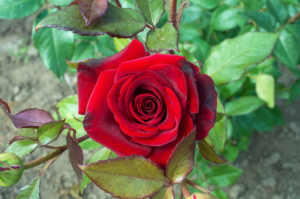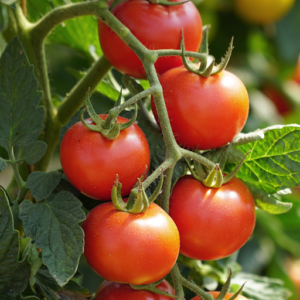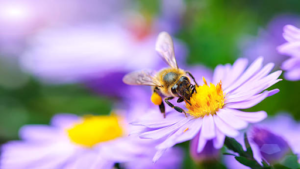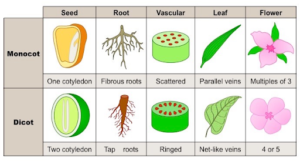Magnifying Your Garden: Angiosperms
Written By: Kathy Liu
Edited By: Linda Qi & Nandita Salwan
Designed By: Kathy Liu
Published By: Linda Qi
Looking at the plants in your garden, each individual burst of vivid hues works together to build the rich landscape in your backyard. However, there is much more than that meets the eye. Plants can be separated into four main groups: lycophytes, pteridophytes, gymnosperms, and angiosperms. Today, the spotlight will be on angiosperms, a crucial plant group that humans have consistently relied on. Classified by their reproductive means, angiosperms are often referred to as “flowering plants.” This is due to the fact that they are divided on the basis that their seeds are enclosed within a fruit.
Prepare to delve into a world of plant classifications, detailing the groups that angiosperms can be further split into, their methods of reproduction and crucial real-life applications of such plants. While the concept may initially seem foreign, angiosperm plants are much more common than you might think. Some examples of well-known angiosperms you might have in your garden include roses, corn, tomato plants, and lavender.



Applications of Angiosperms
Why are angiosperms important? Considering the everyday applications of plants, angiosperms’ role as a flowering plant is omnipresent and consistently applicable. Through taking advantage of angiosperms, humans are able to manufacture everyday products such as cornstarch and flour. Simple aspects of life, like taking in the natural beauty of freshly bloomed petals or tasting the first savoury bite of a ripe tomato, stem back to angiosperms. Not only that, but the abundance of angiosperms allows the plants to play a major role in purifying the air. Accounting for up to 80% of the world’s plants, angiosperms are a key player in exchanging carbon dioxide for the oxygen we need to survive.
Down to the smallest organisms, angiosperms remain relevant. An example of this is bees, an insect that relies on the nectar of flowering angiosperms to create honey and build hives. Humans even rely on angiosperms for many ingredients used in modern medicine. Most famously, morphine, a common pain-managing medication used in hospitals, is derived from the opium poppy, an angiosperm. Therefore, it can be easily concluded that angiosperms play a crucial part in contributing to the daily functions of both the natural and man-made worlds.


Monocots v.s Eudicots
Angiosperms can even be split down further into two groups: monocots and eudicots. It is estimated that 25% of angiosperms are monocots, while the other 75% are eudicots. There are a variety of differences that distinguish the two, ranging from seed type as well as root systems. However, the primary difference between monocots and eudicots presents itself in their seed leaves, or, their cotyledons. Cotyledons are essentially the first leaves to appear from a germinating seed, a significant part of the plant’s embryo. Monocots, true to their name, only have one cotyledon, while eudicots have two. This is best shown through observing the development of different angiosperms. For reference, an example of a monocot is corn. It has only one cotyledon, as displayed through its individual kernels. In contrast, when you observe something like a peanut, you can clearly see more than one cotyledon by counting the number of nuts inside its brittle encasing.
Roots are a deeper but just as useful method of discovering the identity of an angiosperm. The root system of a monocot looks rather spread out, with narrow, thin roots branching out from each other–these are known as fibrous roots. In contrast, eudicots possess what is known as a taproot system, with one single thick root growing downwards, small segments branching out. When identifying one, it is useful to remember that the main segment of the root looks similar to a carrot!
Relating to the stem structure, the vascular bundles in eudicots and monocots differ. Vascular bundles are structures that are designated to transport nutrients, consisting of xylem and phloem. In monocots, the bundles are in a scattered pattern, spread evenly around the stem, whereas with eudicots, the bundles formed a ringed pattern. This difference is apparent in the diagram below. Finally, a more visible difference between monocots and eudicots lies within their leaves and their flowers. Monocots have parallel veins running across their leaves while eudicots(also known as dicots) have one vein with multiple smaller veins branching from it. Subsequently, the leaves in eudicots form a net-like pattern.
Finally, monocots and eudicots experience a math-related difference in their flower petals. The number of flower petals differ depending on the type of flower being examined–in monocots, you will find flower leaves typically arranged in multiples of three. This means that an angiosperm, as long as it has petals that are divisible by three, can be classified as a monocot. With eudicot, a similar rule is applied–however, instead of petals that are multiples of 3, they are multiples of four or five. The next time you’re out, stop at a nearby flower and count the petals-you’ll be surprised at what you can observe!
Key Takeaways:

Conclusion
Angiosperms are a complex and fascinating category of plants to study. Beyond monocots and eudicots, there are many aspects of them that have not been covered in this article in the interest of brevity. Through this article, you have learned about the key types of angiosperms, and their role in the world. This lays the foundation for future knowledge such as the reproductive process of angiosperms. Have fun researching! Delving into the natural world, there are countless intricate explanations about simple, everyday phenomena humans don’t question due to the regularity of the occurrence. However, once one holds a magnifying glass to these occurrences, the natural beauty and wonder of them is permitted to shine through. Don’t be afraid or stall on holding up your magnifying glass. Discover and explore the world!
________________________
Works Cited
https://www.dictionary.com/browse/vascularbundle#:~:text=for%20vascular%20bundle-,vascular%20bundle,arrangements%20dispersed%20throughout%20the%20stem.
https://www.sciencedirect.com/topics/agricultural-and-biological-sciences/eudicot#:~:text=Abstract,contributed%20to%20sustaining%20human%20civilization.
https://u.osu.edu/eeob3320/category/angiosperms/#:~:text=Angiosperms%20provide%20an%20enormous%20environmental,variety%20of%20organisms%2C%20including%20humans.https://homeguides.sfgate.com/differences-between-eudicot-monocot-seeds-84033.html
https://www.britannica.com/plant/angiosperm
https://www.sciencedirect.com/topics/agriculturalandbiologicalsciences/eudicot#:~:text=Abstract,contributed%20to%20sustaining%20human%20civilization.https://www.dictionary.com/browse/vascularbundle#:~:text=for%20vascular%20bundle-,vascular%20bundle,arrangements%20dispersed%20throughout%20the%20stem.
Image Sources
https://www.thespruce.com/indeterminate-tomato-variety-1403423
https://www.britannica.com/plant/corn-plant
https://www.gardeningknowhow.com/ornamental/flowers/roses/red-roses-for-the-garden.htm
https://www.homedepot.com/c/ai/tips-for-growing-tomatoes/9ba683603be9fa5395fab90298ab339
https://www.istockphoto.com/photos/bee-pollination
https://ib.bioninja.com.au/higher-level/topic-9-plant-biology/untitled-3/monocots-versus-dicots.html

